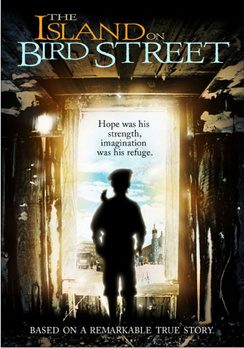 Imagine it. Imagine someone came and built a high wall right around your neighborhood so that you couldn’t get out. That’s what the Nazis did to us.
Imagine it. Imagine someone came and built a high wall right around your neighborhood so that you couldn’t get out. That’s what the Nazis did to us.
Many people cannot imagine the Holocaust. While filled with facts and details, school textbooks and documentaries often fail to tell the story of this horrible tragedy adequately. The autobiographical accounts of witnesses and survivors told in books and movies often play an important role by making people see the realities of the Nazi era.
Some of the most touching and excruciating stories are those in which the accounts are told from a child’s viewpoint. Coming of age is never easy, even under normal circumstances, but coming of age under constantly life-threatening conditions and surviving is a close exemplification of the power of the human spirit. Not all stories have a happy ending. Films such as Edges of the Lord (2001) and The Boy in the Striped Pajamas (2008) stick to the viewer’s mind regardless of age or educational level.
Just as powerful is the 1997 film The Island on Bird Street. It is a movie based on the book of the same name by Uri Orlev. The main protagonist of the film is twelve-year-old Alex (Jordan Kiziuk). He lives with father and uncle in the Jewish ghetto set up by the Nazis as a temporary holding place. Almost every day, soldiers enter the ghetto and select people – people that are taken away – deported out of the ghetto to an unknown destination and fate. The residents are told that the deportees are being sent to work at countryside farms. Yet, some suspected the truth and fled. Some parents tried to hide their children, as did Alex’s dad Stephen.
One day, following an order for a liquidation of the ghetto, the Gestapo captured all inhabitants, including Alex and his family. After promising his son that no matter what happened he would come back for him, Alex’s dad is taken away from the others and searched. His uncle sacrifices himself by attracting the attention of the German soldiers, allowing Alex to escape, managing to hide himself in the ruins. The very next day, the ghetto looks like a ghost town. The streets and the houses are empty, and Alex is all alone, with no-one but his pet mouse Snow and his favorite book, the novel “Robinson Crusoe”, to keep him company.
Without a doubt, The Island on Bird Street is one of the best war dramas I have seen. The plot was intriguing and the action intense. I liked the parallel between the protagonists’ fate in Daniel Defoe’s novel and the little Jewish boy who, left alone, used his every instinct to survive against all odds to avoid being captured. Thanks to the masterful use of the camera and lighting the scenes, the film’s director, Søren Kragh-Jacobsen, made sure that the atmosphere of the Lodz Ghetto is not only seen but felt by viewers. His previous experience in directing coming of age films (including Rubber Tarzan, the review of which you can find on this site, and The Boys from St. Petri – in both working with young actors) helped young Jordan Kiziuk, a kid with little acting experience, to deliver an outstanding performance in the role of the young Alex. The music score of Zbigniew Preisner added an additional layer of suspense and tension to the movie. The Island on Bird Street was filmed in Poland and Germany with English dialogue. Most actors have a notable accent when speaking English (evidence that the film’s cast was genuinely international). But instead of hurting the movie, this fact only made it more believable. In comparison, the fluent English of the characters in I am David, another war-themed coming-of-age drama, took away a lot of that film’s authenticity.
The Island on Bird Street combines some of the best features of the excellent coming of age dramas – a first-person narrative, a view of the world through the eyes of a child, a forced passage to adult responsibilities, and a captivating story that people will remember after the final credits roll. The film’s story holds the message about the power of hope and a lesson about an important period of human history.
After seeing the film, I started exploring various resources related to the Holocaust (such as the story of the Lodz Ghetto published at About.com) and am positive that most viewers are likely to feel a similar urge. Some (including myself) may say that the film is a bit optimistic at times (it’s never predictable although it’s based on the semi-autobiographical novel written by Uri Orlev – a survivor himself). My research also discovered that, in real life, the fate of Alex’s alter ego – writer Uri Orlov himself – differs from what is shown on screen. This concern is best addressed by the film’s director at the 1997 film festival in Berlin :
 Basically, the portrait of 12-year-old Alex – as he is called in the film – is the story of a survivor, with both Dickens and Hugo in it. During five months in the Warsaw ghetto, he is kept alive by the hope that his father will return. Their lives have been hell during Nazi anti-semitism. But like most children, he understands how to live in the present and squeeze a little optimism out of the most hopeless situations.source
Basically, the portrait of 12-year-old Alex – as he is called in the film – is the story of a survivor, with both Dickens and Hugo in it. During five months in the Warsaw ghetto, he is kept alive by the hope that his father will return. Their lives have been hell during Nazi anti-semitism. But like most children, he understands how to live in the present and squeeze a little optimism out of the most hopeless situations.source
Film title: The Island on Bird Street | Release year: 1997 | Director: Søren Kragh-Jacobsen
Cast: Jordan Kiziuk,Patrick Bergin,Jack Warden,Simon Gregor,Sian Nicola Liquorish,Nigel John Whitear and others